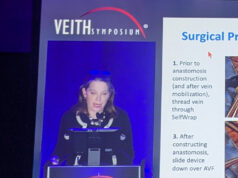
A range of issues in cannulation in arteriovenous fistulas (AVF) have been laid out by Deborah Brouwer-Maier (Transonic Systems, Ithaca, USA) at VEITHsymposium (15–19 November, New York City, USA). Her presentation compared surgical arteriovenous fistulas (AVFs) with endovascular AVFs, dwelling particularly on the difficulties presented by the latter procedure.
Focusing first on surgical AVFs, Brouwer-Maier said that they usually require a “long maturation time before [they are] big enough for successful cannulation.” The surgery required to choose an AVF location and identify the flow direction also tends to leave scarring, she said, while infiltrations are common and the procedure demands a “wide range of cannulation skills” from dialysis staff. EndoAVF she contrasted with sAVF by pointing to its shorter maturation times—though she did note that it “looks different when ready for cannulation”—and the lack of scarring in the identification of AVF location and flow. Nevertheless, she said, the two methods of fistula creation share a relatively high risk of infiltration.
Brouwer-Maier moved on to examine the difference in monitoring between the two. Identifying and palpating the cannulation zone is typically easier in sAVF, she stated, requiring none of the special training given to staff for endoAVF. Arterial and venous needles may not be in the same outflow vessel as EndoAVF can have dual outflow vessels, while the sAVF is “typically a single outflow vessel.”
More specifically considering cannulation zone differences, Brouwer-Maier argued that finding the appropriate zone in endoAVF was more demanding because they could cross the antecubital fossa. Needle infiltration is less of a risk with sAVF, whereas endoAVF “may require the elbow to be fully extended for cannulation.” Movement of the arm therefore must be much more limited during haemodialysis, making for a more uncomfortable therapy.
The presentation did pick out some challenges unique to sAVF. Brouwer-Maier called it “not uncommon” for there to be a “deep cannulation zone” with sAVF, while endoAVF could be shallower. This, in turn, means endoAVF does not usually require as steep an angle of entry as sAVF, she claimed.
Finally, she suggested that “knowledge overcomes cannulation challenges” for endoAVF, and urged clinicians to learn about the WavelinQ and Ellipsys cannulation systems in order to ease the difficulties associated with the procedure.











